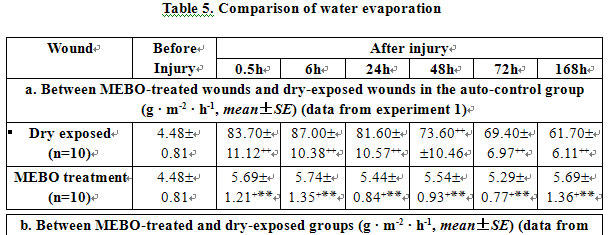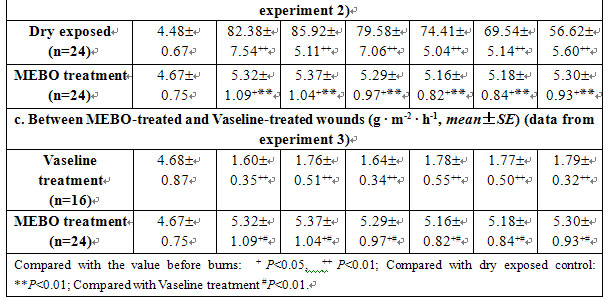Experimental Study on Maintaining Physiological Moist Effect
作者:Rong Xiang Xu 出版社:KARGER 发行日期:In 2004INTRODUCTION
The essential therapeutic principle of BRT with MEBT/MEBO is to keep the burn wound in a physiological (moist) environment in order to promote the graceful discharge and removal of necrotic tissues as well as the regeneration of healthy tissue from the wound. Only BRT with MEBT/MEBO offers this therapeutic advantage. No other burns protocol offers what is unique to BRT - the ability of maintaining a moist physiologic wound environment while at the same time, optimizing efficient drainage.
MATERIALS AND METHODS
Forty-two healthy adult rabbits of both sexes (including nonpregnant females) weighing 2.1~3.0 kg were used in this study. Animals had their backs depilated via application of 8% sodium sulfide solution. Anesthesia was achieved by intraperitoneal injection of pentobarbital sodium (40 mg/kg). On each side of the back, one deep second-degree burn wound was formed by igniting a heated cake of copper, 3 cm in diameter copper plate at 100C for 4 s. The depth and tissue characteristics of the wound were verified by pathological examination.
Vaseline was produced by Yangzizhou Pharmaceutical Factory, Nanchang City, P.R. China. Model EPIC evaporometer (Servomed) was used for measuring wound evaporation.
Experiment 1. BRT with MEBT/MEBO treatment with auto-control: Ten rabbits were used in this experiment. The water evaporation value of normal skin was measured before injury. Then the animal was burned on both sides of the back. The wound on one side was treated with MEBO, while wound on the other side was allowed to dry expose spontaneously as auto-control. MEBO was applied to a thickness of 0.5-1 mm and reapplied at an interval of 6 - 8 h. Measurement of wound water evaporation was done at 0.5, 6, 24, 48, 72 and 168 h postburn. The healing time of each wound was recorded.
Experiment 2. BRT with MEBT/MEBO treatment with dry-exposed therapy control: Twenty-four rabbits were randomly divided into 2 groups, MEBO treatment and dry-exposed therapy group, 12 in each. The treatment method and observations were done as described in experiment 1. Pathological examinations were conducted at the same time.
Experiment 3. Vaseline treatment: Eight rabbits with deep second-degree burns wounds on both sides of the back were treated with Vaseline. The treatment method and observations were done as described in experiment 1. The results were compared with the MEBO-treating group.
The ambient temperature was 25-28C and humidity 50±5 %. The data were presented as mean value±SD and analyzed statistically using t test.
RESULTS
Wound Water Evaporation:
Compared with normal skin, the water evaporation values of burns wounds treated with dry-exposed therapy in both experiments 1 and 2 increased dramatically and reached their peaks at 6 h postinjury, and then tended to decrease slowly. Conversely, the water evaporation of wounds treated with MEBO was much lower (P<0.01, Tables 5a, b). The water evaporation of wounds in the Vaseline-treated group was always kept at a low level, significantly different from that of normal skin as well as MEBO treated wounds (P<0.01, Table 5c).


Gross Observation:
After injury, the wounds in all three experimental groups appeared pale or red-white, with inflammation and swelling above the level of wound edge. Wounds treated with dry-exposed therapy gradually dried and sunk below the level of the wound edge. Wounds treated with MEBO remained moist and swellings subsided within 48 h postburn. Necrotic tissues began to liquefy from superficial to interior and were removed. In experiment 1, MEBO-treated wounds healed more quickly than the dry-exposed auto-control wounds. The difference was statistically very significant (P<0.01, Table 6). Wounds treated with Vaseline became macerated after 6 h and were getting worse with serious and persistent tissue edema. The eschar dissolved earlier than wounds treated with MEBO.

Pathological Examination
Paraffin-embedded sections of the wound tissues in the 3 experimental groups were stained with hematoxylin and eosin staining, and then examined under a light microscope. All of them proved to have pathological changes of deep second-degree burn injury and the pathological changes were almost the same at half an hour postinjury. After 6 h, the injured tissue became loose and there was vacuolar degeneration of cells and attenuation of fiber tissues. These changes were most serious in wounds treated with Vaseline. Micro blood vessels were dilated and had embolism and infiltration of a few white blood cells. After 24 h in dry-exposed treated wounds, the zone of necrosis expanded and deepened continuously. The microcirculation was further blocked with embolism and infiltration of a large amount of inflammatory cells (mainly neutrophils) occured. After 48 h, a zone of leukocyte infiltration was formed around the junction of necrotic and surviving viable tissues. This phenomenon became increasingly obvious as time passed. In MEBO-treated wounds, tissue in the zone of stasis recovered rapidly. Micro blood vessels showed some dilation and congestion. Infiltration of inflammatory cells was scattered in the micro blood vessels. After 48 h, the cells concentrated on the junction of necrotic tissue and where MEBO was applied to form a dense area. In Vaseline-treated wounds, pathological changes were quite different from those in the MEBO-treated ones. Vacuolar degeneration of tissues was more serious and the inflammatory reaction was diffused.
CONCLUSION
This research revealed that burns wounds treated with MEBO had less water evaporation than those treated with conventional dry-exposed therapy. The rate of evaporation was approximate to that of normal skin. Unlike Vaseline, MEBO had excellent permeability allowing active drainage of excreta. MEBO demonstrated that its moist physiological environment is favorable to wound healing.
DISCUSSION
Burn injury destroys the body surface barrier. Injured skin loses its ability to prevent evaporation of water from the body. This results in an excessive loss of body fluid from the lesion area which itself is a stress against healing since a burn wound that is allowed to dehydrate will be further injured by dehydration and necrosis. For deep second-degree burns wounds, the injured tissue in the zone of stasis can be rescued, but excessive drying will cause irreversible damage. This tendency to dehydration is a main disadvantage of conventional dry-exposed therapy. Studies of pathophysiology teach that a moist environment is favorable for the regeneration and repair of injured tissue. The specially designed MEBO ointment alone succeeds in creating an environment in which burns wounds can remain exposed while avoiding the ravages of dehydration and maceration.
The key to the maintaining of water in burns wounds is to prevent evaporation. The results of this study revealed that burns wounds treated with MEBO had significantly less evaporation than those given dry-exposed therapy. MEBO is different from other medical lubricants or ointments such as Vaseline in that MEBO retains wound moisture while keeping the wound surface permeability. For example, excessive water can permeate through the MEBO ointment layer and be removed easily. The difference between water evaporation of MEBO-treating and Vaseline-treated wounds was very significant (P<0.01). This was proved by the test of skin sweat excretion [1]. What attracts our great attention was that although the water evaporation of burns wounds treated with MEBO was significantly different from that of normal skin (P<0.05), the difference between the mean values was less impressive. MEBO’s water retention abilities have been compared to sebum. MEBO maintains wound moisture without compromising drainage, therefore comprising a moist environment that is optimal for wound repair and healing [2].
It has been reported that there is a zone of thermal injured tissue with viability in the deep part and the surroundings of coagulated tissue postburn. This is called the zone of stasis [3]. Blood flow of micro blood vessels in this zone diminishes progressively after burns, and remains very susceptible to further injury. Dehydration or mechanical injury will tip the scale toward tissue necrosis in this zone of stasis. Therefore, it is really difficult to distinguish this zone from the initially coagulated tissue that presents after 5 days postburn. This tendency to allow the zone of stasis (a recussible wound state) to deteriorate into a non-recussible death state is consistent with conventional dry-exposed therapy. By comparison, MEBO inhibited the deterioration of this process by avoiding secondary injuries such as dehydration. Therefore, MEBO promotes the recovery of tissues within the zone of stasis and thus proves favorable to wound tissue regeneration and repair. Burns wounds treated with MEBO healed more quickly than those treated with dry-exposed therapy (P<0.01). This result could not be attributed to the moisture maintaining effect of MEBO alone, but without a moist environment, it is hard for any medical treatment to achieve [2]. Vaseline treatment, though it also kept the wound moist but macerated, resulted in suboptimal changes in wound tissues as opposed to the healthy tissue resulting form MEBO treatment. Based on our results, MEBO provided a physiologically moist environment uniquely favorable to wound tissue regeneration and repair.
The unique dosage form and pharmacokinetic features of MEBO are responsible for its moisture-maintaining effect. The following three aspects may account for the mechanism of its action:
1. MEBO has its unique dosage form with frame structure, which, when applied on the wound, warms and morphs into an equilibrium of two phases, liquid and semisolid. It isolates the wound from external irritation and prevents excessive water evaporation from the wound surface.
2. MEBO has an active drainage effect whereby excessive water, liquefaction products and excreta are passively and automatically removed through the drug layer [2, 4].
3. MEBO base contains hydrophilic and lipophilic groups and has high surface activity. It has higher affinity to the wound tissue than water, which allows for the formation of a strong adsorptive film on the wound which protects it from either maceration or dehydration.
REFERENCES
1. Xu RX: Moist exposed burn therapy (MEBT): Textbook for Technological Training. Beijing, Beijing Guangming Chinese Medicine Institute for Burns, Wounds and Ulcers, 1989, pp160-168.
2. Xu RX: The medical science of burns and ulcers: A general introduction. Chin J Burns Wounds Surface Ulcers, 1989; 1: 11-21.
3. Research Group For Burns of The Third Military Medical University: Burn therapy. Beijing, People’s Health Publishing House, 1977, p125.
4. Du HE: The micro-mechanism of moist exposed burn ointment. Chin J Burns Wounds Surface Ulcers, 1993, 5: 9-10.









